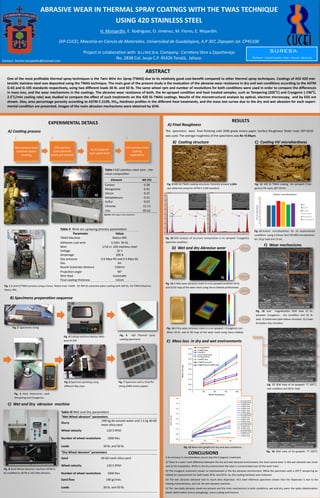
Poster Cancún 2014 HR
- 1. ABRASIVE WEAR IN THERMAL SPRAY COATNGS WITH THE TWAS TECHNIQUE USING 420 STAINLESS STEEL DIP-CUCEI, Maestría en Ciencia de Materiales, Universidad de Guadalajara, A.P 307, Zapopan Jal. CP45100 H. Monjardín, E. Rodríguez, O. Jiménez, M. Flores, E. Mojardín. Project in colaboration with SURESA Company, Carretera libre a Zapotlanejo No. 2838 Col. Jauja C.P. 45426 Tonalá, Jalisco. SURESA Spray coatings for your needs Contact: hector.monjardin@hotmail.com ABSTRACT One of the most profitable thermal spray techniques is the Twin Wire Arc Spray (TWAS) due to its relatively good cost-benefit compared to other thermal spray techniques. Coatings of AISI 420 mar- tensitic stainless steel was deposited using the TWAS technique. The main goal of the present study is the evaluation of the abrasive wear resistance in dry and wet conditions according to the ASTM G-65 and G-105 standards respectively, using two different loads 30 lb. and 50 lb. The same wheel rpm and number of revolutions for both conditions were used in order to compare the differences in mass loss, and the wear mechanisms in the coatings. The abrasive wear resistance of both, the As-sprayed condition and heat treated samples, such as Tempering (205o C) and Cryogenic (-196o C, 2.5o C/min cooling rate) was studied to compare the effect of such treatments on the 420 SS TWAS coatings. Results of the microstructural analysis by optical, electron microscopy, and by EDS are shown. Also, area percentage porosity according to ASTM E-2109, HV50 Hardness profiles in the different heat treatments, and the mass lost curves due to the dry and wet abrasion for each experi- mental condition are presented. Images of the main abrasion mechanisms were obtained by SEM. EXPERIMENTAL DETAILS A) Coating process Table II Wire arc spraying process parameters Parameter Value TWAS Machine Metco 4RC Adhesion coat wire 1/16in Ni-AL Wire 1/16 in. 420 stainless steel Voltage 32 V Amperage 200 A Gas pressure 0.6 Mpa PG and 0.4 Mpa SG Gas Air Nozzle-Substrate distance 150mm Projection angle 90° Wire feed Automatic Final coating thickness >2mm IV) Fig. 1 I) and II) TWAS process using a Fanuc Robot mod. S420F, III) 304 SS substrate plate coating with 420 SS, IV) TWAS Machine Metco 4RC, B) Specimens preparation sequence The specimens were final finishing until 2000 grade emery paper. Surface Roughness Tester mod. SRT-6210 was used. The average roughness of the specimens was Ra =0.94µm. A) Final Roughness RESULTS B) Coating structure C) Coating HV microhardness C) Wet and Dry abrasion machine Table III Wet and Dry parameters “Wet Wheel abrasion” parameters Slurry .940 kg De-ionized water and 1.5 kg 40-60 mesh silica sand Wheel velocity 120.5 RPM Number of wheel revolutions 1000 Rev. Loads 30 lb. and 50 lb. “Dry Wheel abrasion” parameters Sand 40-60 mesh silica sand Wheel velocity 120.5 RPM Number of wheel revolutions 1000 Rev. Sand flow 190 gr/min. Loads 30 lb. and 50 lb. Fig. 9 420 SS TWAS coating structure. Porosity around 3.26% was obtained using the ASTM E-2109 standard. Fig. 11 420 SS TWAS coating (As sprayed+ Cryo- genics) HV mark, 807.59 HV. 0 50 100 150 200 250 300 350 400 450 500 550 600 650 700 750 800 850 HVmicrohardness Vickers microhardness As As+TT As+Crio As+TT+Crio As+Crio+TT As+TT+Crio+TT Fig. 12 Vickers microhardness for all experimental conditions using a Future Tech FM-800 microdurome- ter, 50 gr load and 15 sec. D) Wet and dry Abrasive wear Fig. 8 Sand Wheel abrasion machine ASTM G- 65 modified to ASTM G-105 Wet abrasion. Fig. 13 I) Wet wear abrasion mark in a As-sprayed condition 50 lb. and II) 3D map of the wear mark using Vecco Dektak profilometer. Fig. 14 I) Dry wear abrasion mark in a As-sprayed + Cryogenics con- dition 50 lb. and II) 3D map of the wear mark using Vecco Dektak E) Mass loss in dry and wet environments I) II) III) F) Wear mechanisms Fig. 16 Low magnification SEM view of As- sprayed+ Cryogenics , dry condition and 50 lb. load, A) Deformed splat before remotion, B) Crater formation due remotion. Fig. 17 SEM view of As-sprayed+ TT 205o C, wet condition and 30 lb. load. Fig. 18 SEM view of As-sprayed+ TT 205o C, Table I 420 stainless steel wire che- mical composition Element Wt (%) Carbon 0.28 Manganese 0.42 Silicon 0.37 Molybdenum 0.15 Sulfur 0.03 Chrome 13.13 Iron 85.62 Source: Washington Alloy Datasheet Fig. 2 Specimens sizing Fig. 3 Cutting machine Metkon Met- acut-M 250 Fig. 4 420 Thermal spray coating specimens Fig. 5 Heat treatments used, Tempering and Cryogenics. Fig. 6 Specimen grinding using different flap sizes Fig. 7 Specimen with a final fin- ishing (2000 emery paper) Fig. 10 EDS analysis of structure composition in As-sprayed+ Cryogenics specimen condition. Fig. 15 Mass loss graphs for dry and wet conditions. CONCLUSIONS I) An increase in microhardness occurs due the Cryogenic treatment. II) There is a wear mark difference between the dry and wet abrasive environment, the most severe wear in the wet abrasion was local- ized at the broadsides. While in the dry environment the wear is concentrated over all the wear mark. III) The cryogenic treatment shown no improvement in the dry abrasion environment. While the specimens with a 205o C tempering ex- hibited an improvement for both loads 30 lb. and 50 lb. So, the coating hardness was irrelevant. IV) The wet abrasion behavior had to much data dispersion. H13 steel reference specimens shown that the dispersion is due to the coating characteristics, and not for wet abrasion machine. V) The two-body abrasion mode are present and the main mechanisms in both conditions, wet and dry, were: the splats delamination, plastic deformation (micro-ploughing), micro-cutting and fracture. I) 153 um 216 um II) I) II) 223 um 368 um H13 Steel specimens